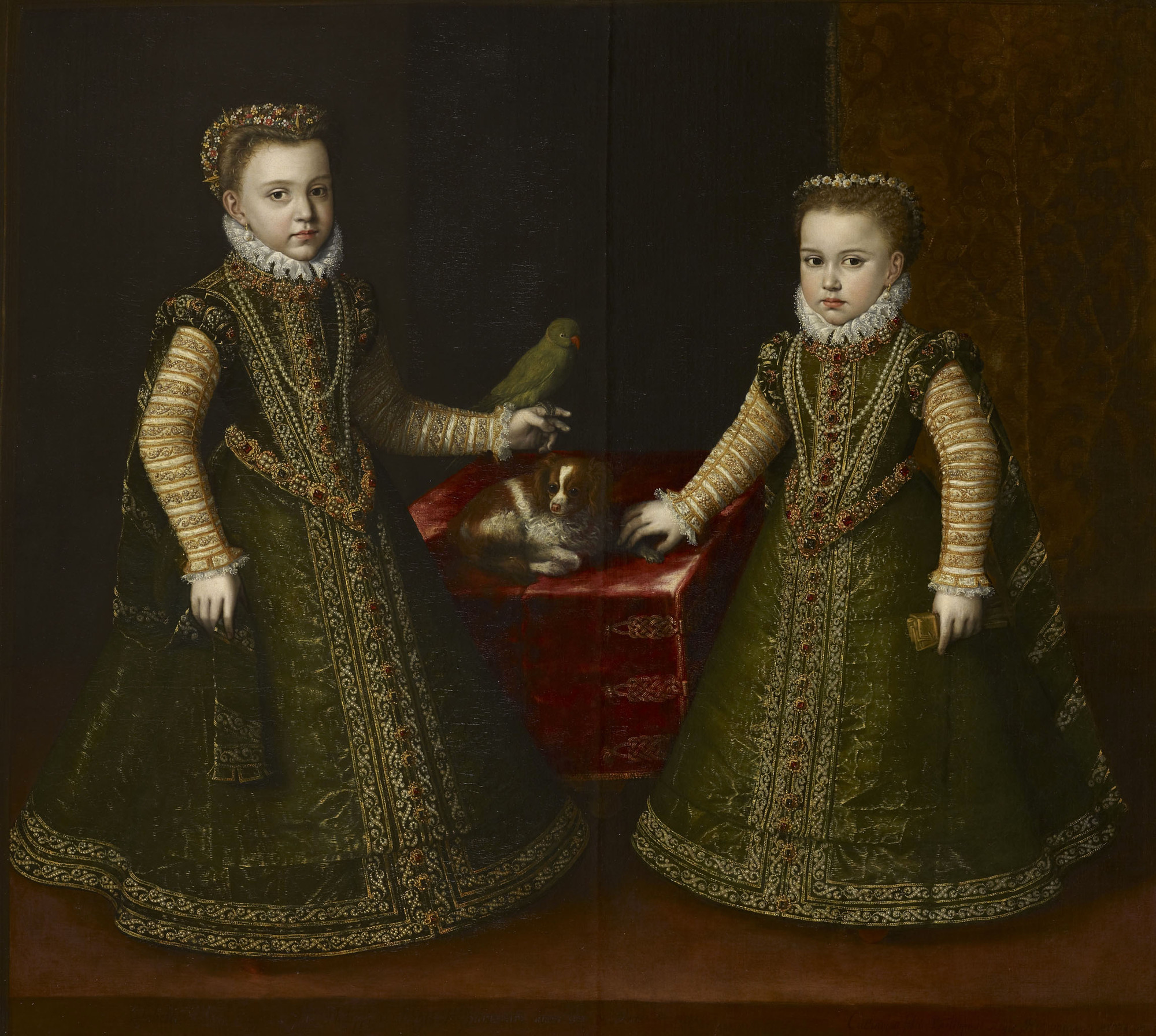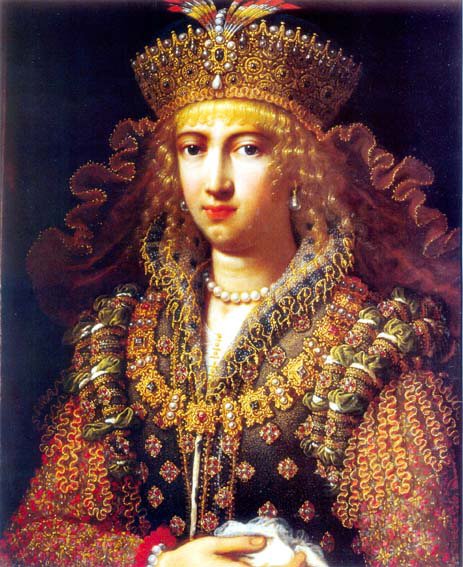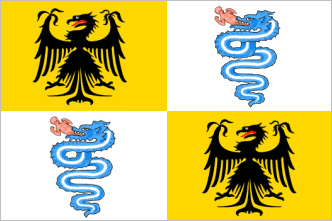|
Giuseppe Maria Gonzaga
Giuseppe Gonzaga (20 March 1690 – 16 August 1746) was the last reigning Duke of Guastalla and a member of the House of Gonzaga. Early life He was the second son of Vincenzo Gonzaga, Duke of Guastalla and his second wife, Princess Maria Vittoria Gonzaga of Guastalla (1659-1707). Giuseppe was mentally handicapped. When his elder brother Duke Antonio Ferrante died in an accident in 1729, Giuseppe was the only remaining male member of the Gonzaga family, so he became duke. Marriage Giuseppe would probably never have married, but when he became duke a marriage was arranged in 1731 with the sixteen-year-old Princess Eleonore von Schleswig-Holstein-Sonderburg-Wiesenburg (1715–1760), daughter of Duke Leopold of Schleswig-Holstein-Sonderburg-Wiesenburg and his wife, Princess Maria Elisabeth of Liechtenstein (1683-1744). She was also granddaughter of Duchess Karolina of Legnica-Brieg. The marriage remained childless. Duchy During the War of Polish Succession the Duchy was occu ... [...More Info...] [...Related Items...] OR: [Wikipedia] [Google] [Baidu] |
Orsini Family
The House of Orsini is an Italian noble family that was one of the most influential princely families in medieval Italy and Renaissance Rome. Members of the Orsini family include five popes: Stephen II (752-757), Paul I (757-767), Celestine III (1191–1198), Nicholas III (1277–1280), and Benedict XIII (1724–1730). In addition, the family included 34 cardinals, numerous ''condottieri'', and other significant political and religious figures. Origins According to their own family legend, the Orsini are descended from the Julio-Claudian dynasty of ancient Rome. The Orsini carried on a political feud with the Colonna family for centuries in Rome, until it was stopped by Papal Bull in 1511. In 1571, the heads of both families married nieces of Pope Sixtus V as an act of reconciliation. Ironically the Colonna family also claims descent from the Julio-Claudian dynasty of ancient Rome. The Orsini descend from Cajo Orso Orsini who lived c. 600 CE. Five popes are descended f ... [...More Info...] [...Related Items...] OR: [Wikipedia] [Google] [Baidu] |
1746 Deaths
Events January–March * January 8 – The Young Pretender Charles Edward Stuart occupies Stirling, Scotland. * January 17 – Battle of Falkirk Muir: British Government forces are defeated by Jacobite forces. * February 1 – Jagat Singh II, the ruler of the Mewar Kingdom, inaugurates his Lake Palace on the island of Jag Niwas in Lake Pichola, in what is now the state of Rajasthan in northwest India. * February 19 – Brussels, at the time part of the Austrian Netherlands, surrenders to France's Marshal Maurice de Saxe. * February 19 – Prince William, Duke of Cumberland, issues a proclamation offering an amnesty to participants in the Jacobite rebellion, directing them that they can avoid punishment if they turn their weapons in to their local Presbyterian church. * March 10 – Zakariya Khan Bahadur, the Mughal Empire's viceroy administering Lahore (in what is now Pakistan), orders the massacre of the city's Sikh people. April–Ju ... [...More Info...] [...Related Items...] OR: [Wikipedia] [Google] [Baidu] |
1690 Births
Year 169 ( CLXIX) was a common year starting on Saturday (link will display the full calendar) of the Julian calendar. At the time, it was known as the Year of the Consulship of Senecio and Apollinaris (or, less frequently, year 922 ''Ab urbe condita''). The denomination 169 for this year has been used since the early medieval period, when the Anno Domini calendar era became the prevalent method in Europe for naming years. Events By place Roman Empire * Marcomannic Wars: Germanic tribes invade the frontiers of the Roman Empire, specifically the provinces of Raetia and Moesia. * Northern African Moors invade what is now Spain. * Marcus Aurelius becomes sole Roman Emperor upon the death of Lucius Verus. * Marcus Aurelius forces his daughter Lucilla into marriage with Claudius Pompeianus. * Galen moves back to Rome for good. China * Confucian scholars who had denounced the court eunuchs are arrested, killed or banished from the capital of Luoyang and official life duri ... [...More Info...] [...Related Items...] OR: [Wikipedia] [Google] [Baidu] |
Infanta Catherine Michelle Of Spain
Catherine Michaela of Spain (; 10 October 1567 – 6 November 1597) was Duchess of Savoy by marriage to Duke Charles Emmanuel I. She ruled the Duchy several times as regent in Charles Emmanuel's absence, notably during his campaign in 1594.Dizionario Biografico degli Italiani – Volume 22 (1979) She was the younger surviving daughter of Philip II of Spain and Elisabeth of Valois. Early life Catherine Michaela was the daughter of Philip II, ruler of the vast Spanish Empire, and his third wife, the French princess Elisabeth of Valois. She was described as beautiful, intelligent, arrogant and well aware of her high social status. Though her father did not attend her christening and was not as rejoiced at the birth of a daughter as he had been with her elder sister, Isabella Clara Eugenia, she had a good relationship with him. Philip and Catherine Michaela exchanged letters throughout her life. She had a close relationship with her sister. They were raised together under the care ... [...More Info...] [...Related Items...] OR: [Wikipedia] [Google] [Baidu] |
Charles Emmanuel I, Duke Of Savoy
Charles Emmanuel I ( it, Carlo Emanuele di Savoia; 12 January 1562 – 26 July 1630), known as the Great, was the Duke of Savoy from 1580 to 1630. He was nicknamed (, in context "the Hot-Headed") for his rashness and military aggression. Being ambitious and confident, Charles pursued a policy of expansion for his duchy, seeking to expand it into a kingdom. Biography Charles was born in the Castle of Rivoli in Piedmont, the only child of Emmanuel Philibert, Duke of Savoy and Margaret of France, Duchess of Berry. He succeeded his father as duke on 30 August 1580. Well-educated and intelligent, Charles spoke Italian, French, Spanish, as well as Latin. He proved an able warrior although short and hunchbacked. In the autumn of 1588, taking advantage of the civil war weakening France, he occupied the Marquisate of Saluzzo, which was under French protection. The new king, Henry IV, demanded the restitution of that land, but Charles Emmanuel refused, and war ensued. In 1590 he s ... [...More Info...] [...Related Items...] OR: [Wikipedia] [Google] [Baidu] |
Virginia De' Medici
Virginia de' Medici (29 May 1568 – 15 January 1615) was an Italian princess, a member of the House of Medici and by marriage Duchess of Modena and Reggio. Regent of the Duchy of Modena and Reggio in 1601 during the absence of her husband, she was able to protect the autonomy of the city of Modena from the attacks of the local Podestà and Judge. Her husband's infidelities increased her already erratic behavior and led to a permanent mental illness, which lasted until her death. Life Early years Born in Florence on 29 May 1568,Georgia Arrivo: ''Scritture delle donne di casa Medici nei fondi dell’Archivio di Stato di Firenze'' in: archiviodistato.firenze.it (in Italian) ... [...More Info...] [...Related Items...] OR: [Wikipedia] [Google] [Baidu] |
Cesare D'Este, Duke Of Modena
Cesare d'Este (8 October 1562 – 11 December 1628) was Duke of Modena and Reggio from 1597 until his death. Biography Born in Ferrara, Cesare was the son of Alfonso d'Este, Marquis of Montecchio, fourth son of Alfonso I d'Este and the cousin of Alfonso II d'Este, duke of Ferrara and Modena. When the latter died without heirs in the October 1597, Cesare inherited the duchy. The legitimacy of the succession was recognised by the Emperor Rudolph II but not by Pope Clement VIII: thus, as Ferrara was nominally a Papal fief, the city was returned to the Papal States, despite the attempts of the young duke, who sought help from the major powers to no avail.. The capital was therefore moved to Modena, which he entered on 30 January 1598. His first years were troublesome: he had to face the quarrels between the Modenese and Ferrarese nobles who had come with him, the attempt at independence of Maro Pio of Sassuolo, and a war against Lucca for the possession of Garfagnana. Mar ... [...More Info...] [...Related Items...] OR: [Wikipedia] [Google] [Baidu] |
Virginio Orsini, Duke Of Bracciano
Virginio Orsini (September 1572 – 9 September 1615) was the second Duke of Bracciano, member of the Orsini family and knight of the order of the Golden Fleece. He was the son of Paolo Giordano I Orsini and Isabella de' Medici, and inherited his father's titles and fiefs after his death in 1585. In 1589 he married Flavia Peretti, a niece of Pope Sixtus V, by whom he had 11 children. His son Paolo Giordano became a prince of the Holy Roman Empire through his marriage with Isabella Appiani, princess of Piombino. Virginio Orsini was a supporter of the Earl of Essex and visited the English court for the Christmas revels in December 1600. He was entertained by Shakespeare's ''Twelfth Night'' and the play opens with the character of Duke Orsino saying the famous line "If music be the food of love, play on." Queen Elizabeth danced a galliard The ''galliard'' (; french: gaillarde; it, gagliarda) was a form of Renaissance dance and music popular all over Europe in the 16th ce ... [...More Info...] [...Related Items...] OR: [Wikipedia] [Google] [Baidu] |
Doria (family)
The House of Doria ( lij, Döia ) originally ''de Auria'' (from ''de filiis Auriae''), meaning "the sons of Auria", and then ''de Oria'' or ''d'Oria'', is an old and extremely wealthy Genoese family who played a major role in the history of the Republic of Genoa and in Italy, from the 12th century to the 16th century. Numerous members of the dynasty ruled the republic first as Capitano del popolo and later as Doge. Origins According to legend, a noble Genoese lady named Auria or Oria della Volta fell in love with a noble pilgrim who was going to Jerusalem for the First Crusade; his name was Arduino di Narbonne but their children were named after the mother—''de Oria'', the children of Oria. Arduino was a typical name of the Arduinici family of the Piemonte, some of whose members bore the title of Counts of Auriate; one might then speculate that one of the Arduinici of Auriate gave origin to this family, which suddenly appears in history as a local major power in Liguria in th ... [...More Info...] [...Related Items...] OR: [Wikipedia] [Google] [Baidu] |
House Of Borromeo
), type=Noble family, country=, estates= Rocca d'Angera Palazzo Borromeo, Milan Castel of Peschiera Borromeo Borromean Islands Villa Borromeo, Arcore, titles=* Prince of Angera * Marquess of Romagnano * Count of Arona * Count of Peschiera * Lord of Cannobio and Vergante * Lord of Vogogna and Val Vigezzo, styles=''Don'' or ''Donna'', founded=, founder= Vitaliano I, current head=Vitaliano XI, deposition=, ethnicity=Italian, cadet branches=Borromeo Arese The aristocratic House of Borromeo were merchants in San Miniato around 1300 and became bankers in Milan after 1370. Vitaliano de' Vitaliani, who acquired the name of Borromeo from his uncle Giovanni, became the count of Arona in 1445. His descendants played important roles in the politics of the Duchy of Milan and as cardinals in the Catholic Reformation. In 1916 the head of the family was granted the title Prince of Angera by the King of Italy. The best known members of the family were the cardinals and archbishops of Mila ... [...More Info...] [...Related Items...] OR: [Wikipedia] [Google] [Baidu] |






_by_Armanino.jpg)
